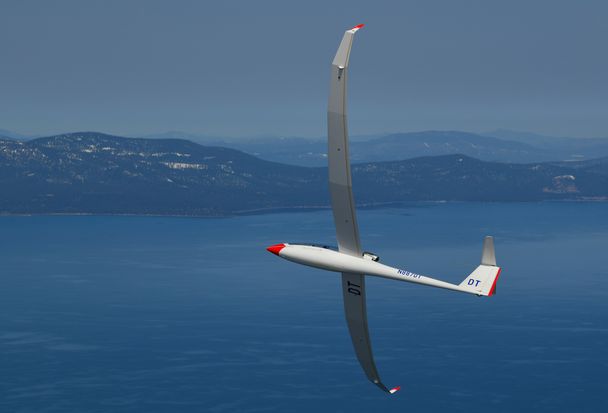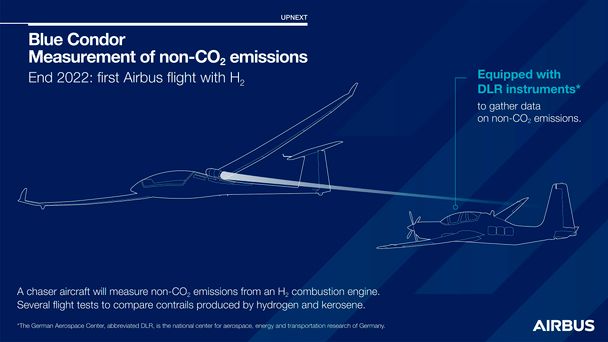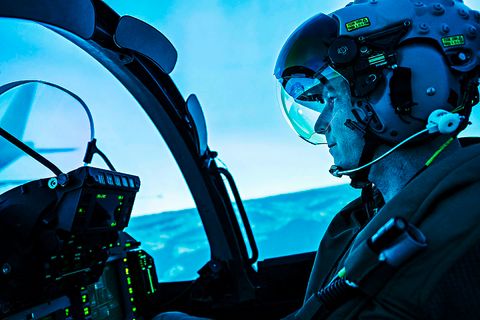How Blue Condor will accelerate Airbus’ first hydrogen-powered test flights

Blue Condor, launched by Airbus UpNext, is taking a modified glider up to 33,000 feet – an extreme altitude for an aircraft that normally cruises below 10,000 feet – to analyse hydrogen combustion’s impact on contrail properties. The result of this analysis will provide critical information on aviation’s non-CO2 emissions, including contrails and NOx, in advance of the ZEROe demonstrator flight testing.
The Arcus-J glider is somewhat of an outlier in the world of aviation. It is configured like any sailplane capable of free flight thanks to its 20-metre wingspan, but with the added advantage of a retractable PBS TJ-100 jet engine to optimise the glider’s self-launching and long cross-country capabilities.
It all started in 2016. Bob Carlton of US company Desert Aerospace converted the Arcus-M, a motorised sailplane, into what is now known as an “Arcus-J jet sailplane.” After retrofitting the glider, Bob and the Arcus-J’s owner Dennis Tito powered up and embarked on the world’s first significant long-soaring flight in a jet-powered sailplane.
Today, there are only a few Arcus-J gliders in the world. Now, two of these gliders have been called upon to undertake the Blue Condor mission – an Airbus UpNext project that focuses on analysing contrails and other emissions from a hydrogen combustion engine by comparing them to those produced by a conventional kerosene engine in the same power class. The Perlan Project, alongside Airbus and its technical partners, will modify one glider and, thanks to Perlan’s world-renowned, high-altitude piloting expertise, will operate the gliders at their limit during each phase of the mission.
A flight test campaign in three phases
The first phase of the Blue Condor project involves modifying one Arcus-J glider. Airbus engineers are replacing the rear pilot seating with a hydrogen-propulsion system. Two 700-bar gaseous hydrogen tanks will provide fuel to the turbojet hydrogen combustion engine. The second Arcus-J glider will remain unmodified, operating on its existing turbojet engine.
Once fully modified, the glider is expected to take its first flight in July 2022. The aim of this first flight test campaign is to validate the overall platform configuration, as well as flight handling in real conditions. A second flight test campaign is planned for November 2022 during which the modified glider will operate exclusively on hydrogen.
The third flight test campaign, scheduled for early 2023, will see a Grob Egrett – another aircraft reputed for its long-endurance and high-altitude test capabilities – steer the two gliders to the test altitude, release them, and then mirror their every movement at speeds of 80-85kts during back-to-back tests. In doing so, the Grob Egrett will act as a “chase” aircraft, capturing critical data thanks to the emissions sensors and associated instrumentation provided by key partner DLR – the German aerospace centre.
“The Blue Condor project is a major milestone on our ZEROe journey as it will launch the first series of in-flight tests using a hydrogen combustion engine at Airbus,” explains Mathias Andriamisaina, Airbus Head of Zero-Emission Demonstrators. “These flight test campaigns will provide an excellent knowledge base on hydrogen’s impact on engine behaviour, contrails and other non-CO2 emissions. This will undoubtedly inform the direction of future flight testing using the upcoming ZEROe A380 test platform.”

An in-depth look at contrails from hydrogen combustion
Analysing contrail properties at near and far fields is a core objective of the Blue Condor project. Indeed, very little research currently exists on contrails produced by hydrogen combustion.
Contrails, or "condensation trails," are clouds of ice crystals that can form behind an aircraft at high altitude. Although hydrogen combustion can produce contrails depending on the ambient atmospheric conditions, they differ significantly to those produced by conventional combustion engines. And because hydrogen combustion emits about 2.6 times more water compared to standard JetA/A1, in-depth analysis is required to understand its full impact on contrails.
Contrail formation and measurement is highly complex. High altitudes and cold environments offer ideal meteorological conditions for contrails to form naturally due to the static temperatures and relative humidity at altitude. A variety of elements is of interest when analysing contrail properties, including the following:
- Ice crystal size, distribution, density and number
- Water vapour in the atmosphere
Blue Condor’s first two flight test campaigns will be carried out in Nevada, USA. The third will be conducted in North Dakota, USA, in partnership with the University of North Dakota, to take advantage of the ideal meteorological conditions.
Contrail characterisation: a key Airbus research area
Contrail characterisation is of significant interest to any future hydrogen combustion aircraft programme. The Blue Condor project is thus a cornerstone of the ZEROe initiative, shedding light on one key aspect of hydrogen-powered flight. In fact, the results of Blue Condor’s three flight test campaigns will play an essential role in preparing the groundwork for the flight-testing phases of the ZEROe demonstrator using the A380 platform.
In addition, the objectives of the Blue Condor project perfectly complement Airbus’ overall climate strategy, which aims to better understand contrails produced by alternative fuel sources. Several Airbus initiatives are currently underway in this respect, including the ECLIF3 and VOLAN flight demonstration projects involving the A350 and A319neo respectively. Both initiatives focus on emissions characterisation, including contrails, related to the use of 100% sustainable aviation fuel (SAF).
“In partnership with the Perlan Project and the DLR, we’re really taking a scholarly and science-based approach to contrail characterisation,” Mathias says. “The use of innovative methods – like a modified glider to reach higher altitudes and a chaser aircraft to capture emissions – also proves that we’re willing to try new things to obtain the data needed to give us a complete picture of aviation’s climate impact.”
The Blue Condor project is a major milestone on our ZEROe journey as it will launch the first series of in-flight tests using a hydrogen combustion engine at Airbus.
Mathias Andriamisaina, Airbus Head of Zero-Emission Demonstrators



